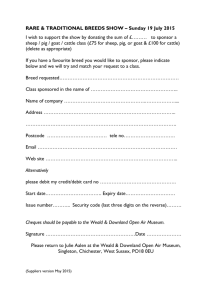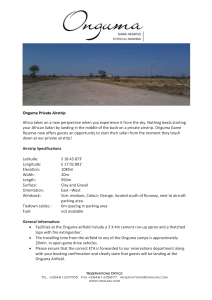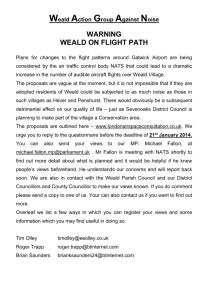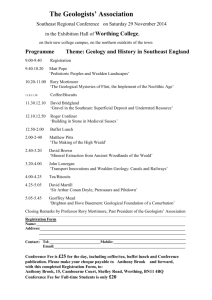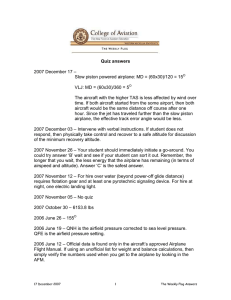North Weald - Epping Forest District Council
advertisement
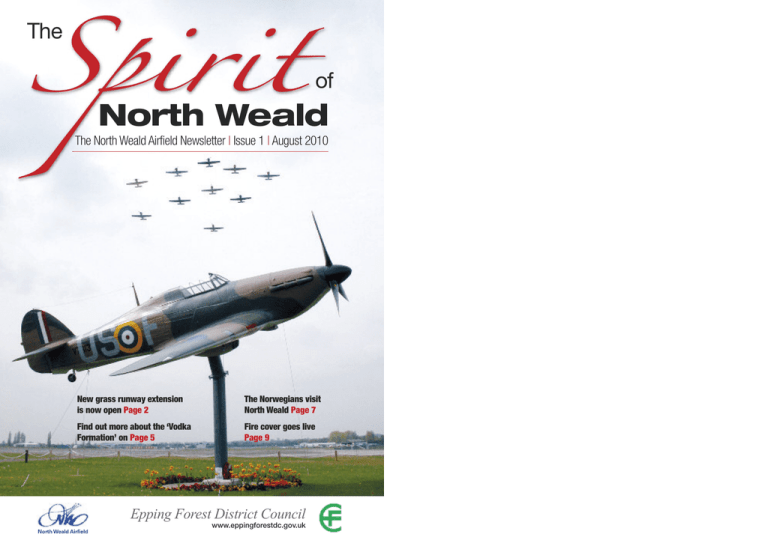
Spirit The of North Weald The North Weald Airfield Newsletter | Issue 1 | August 2010 New grass runway extension is now open Page 2 The Norwegians visit North Weald Page 7 Find out more about the ‘Vodka Formation’ on Page 5 Fire cover goes live Page 9 Epping Forest District Council www.eppingforestdc.gov.uk North Weald Airfield Why airfield bird control is important August Sam Read, Operations Officer responsible for Bird Control explains... Bikefest Runway – 02/20 closed September Welcome to the first issue of the new quarterly newsletter for North Weald Airfield. Sunday 5 Maitland Racing Runway – 02/20 closed Sunday 12 North Weald Airfield Battle of Britain 70th Anniversary Fun Day Sunday 19 VW Players Darren Goodey North Weald Airfield Manager The grass runway 02/20 is extended As the view of the grass taxiway is obscured by trees from the Tower, we request that pilots remain at the Alpha 1 Hold until the Tower confirms that there is no potential conflict in entering the grass taxiway. We will be amending the Airfield Operations Manual in due course to reflect these new instructions. I 2 T H E S P I R I T O F N O R T H 20 RUNW AY 02 /20 UNW AY 02 / MAIN y Alph a A1 Hold Taxiw a Hold at A1 and call the Tower before proceeding down the grass taxiway GRAS SR The runway surface is very smooth, while the taxiway has some bumps so care will be needed to taxy slowly. A range of aircraft have already been using the new extension including a Cessna 172, AT-3, Beech Bonanza and Peter Teichman’s P-51D Mustang, Hurricane and Kittyhawk. Peter is very enthusiatic about the new extension as it will provide a big saving on tyre wear for his warbirds. Crossing the tarmac on Taxiway Alpha on to the existing grass runway has not been a problem for anyone. Taxiw ay Alp h a Grass NEW EXTE NSIO N 20 Grass Hold 20 The grass has been mown to the same width as the current grass runway and a parallel taxiway is also available. We are waiting for grass to grow along the edges to give a clear demarcation and still have to put runway markers and threshold numbers in place on the new extension. A2 Hold Total Runway Length: 735 metres Runway Width: 30 metres RU NW AY 1 W E A L D 3/3 1 – I S S U E 1 H WE I ALD A Taking into account the size of North Weald Airfield, bird strikes are not common, however there is always a great risk, especially with both vintage warbirds and modern-day jets operating from the airfield. ... and is now open for use The Airfield Ops Team has been working with our colleagues in Grounds Maintenance to create an extension to the existing 02/20 grass runway. The new section runs from Taxiway Alpha to the main runway threshold, providing a total of 735 metres for pilots to use. L We aim to report on what is happening around the Airfield so that tenants, other airfield users and the wider North Weald Airfield covers over three hundred acres of open ground, mainly grass, which is what attracts the birds to settle. The grass is cut specifically to eight inches to prevent the birds settling, however depending on the season different birds like to settle on both the grass runway and the concrete runways, which poses a great threat to aircraft. T community can gain a better understanding of the scope of activities that the site encompasses and its history and significance to the locality. NOR Our Airfield is a busy and vibrant site with many businesses either based here or taking advantage of its facilities. Members of the local community use different areas for leisure pursuits and, of course, there is flying in its many forms taking place seven days a week. Bird Control plays a vital part in the day-to-day running of North Weald Airfield. Having a trained Bird Control unit on the airfield is important because of the wide variety aircraft we have based on or visiting the airfield. It is our responsibility to control and limit the number of birds that enter the airfield boundary due D CONTRO to the large risk they have to aircraft. IR ELD Sunday 15 FI North Weald Airfield Public Event Calendar R of B Spirit The We tackle Bird Control in phases. Firstly by monitoring the areas where bird settlement takes place and modifying it so it doesn’t appeal to them: they like short grass as it makes it easier to feed on grubs and insects, for example. Phase Two begins when we have identified where the birds are settling. We then use a number of methods to control and scare them off the airfield site. We do this by using loud speaker systems mounted on a vehicle to project loud noises of predator birds in order to scare the ones on the airfield. We tend to use varied methods in order to scare and control the birds, so they do not become familiar with the routines. Bird control is a full time job at major civil and military airports. However, even at less busy airfields such as North Weald, we still take it seriously in order to maintain a safe environment for aviation. The main bird types we have to deal with are Rooks, Jackdaws, Gulls, Starlings, Pigeons and Lapwings. I John Ratnage retires as Duty Officer We wish him all the best and congratulate Jonathan Warner who replaces him in that role It is difficult being friendly and helpful all the time, but ‘Ratty’ seems to manage it! After 11 years at North Weald following service as a firefighter, he is calling it a day. Knowing him, it will not be long before he is back in some capacity helping around the airfield, which he loves. The North Weald Ops Team wish John and his wife Avril a long and happy retirement. And well done Jonathan for being promoted to Duty Officer! I T H E S P I R I T O F N O R T H John and his favourite red Land Rover! W E A L D – I S S U E 1 3 Back in the 1990s Eddie Yates saw a Vans RV3 aircraft at Stapleford doing aerobatics, and was impressed. He decided to build one himself and chose the two-seat RV6a kit plane from the USA. This was an early version of the kit and required a huge amount of work positioning and drilling holes for the rivets. He started the project in 1999 and finished it in 2004. Eddie in the back seat of the new RV8 returning from the spinning trials with test pilot Andy Hill G-EDRV was painted yellow and named Fast Eddie I. In the first year Eddie flew 120 hours in it. He sold it earlier this year, but the aircraft is still based at North Weald. He then saw a couple of other RV projects and liked what he saw of the improved engineering aspects of the newer kits – rivet holes pre-drilled for example. So, he decided to build another one – this time a tandem seat RV8 taildragger – which would have the best resale value. An air-to-air shot of the RV6 during an RV formation sortie The RV Formation Days Every month for the past couple of years a group of Vans RV aircraft assemble at North Weald from as far away as Dunkeswell in Devon for a day’s formation flying. Starting in pairs and three-ships, the pilots and their coaches practise the basic positions within a formation and the close-in manouevres required. The first few sorties are rather daunting, but now the regulars are flying in formations of up to nine aircraft and performing complex opposition breaks when recovering to the airfield to land. Each sortie is preceded by a formal briefing so that everyone is aware of what is planned and what to do if there is a problem. Likewise after a sortie there is a debrief to learn any lessons from the flight. Normally there is time for two sorties to allow participants to return home at the end of the day. G-IGHT was started in 2006 and finished in April of 2010. It is fully aerobatic and Eddie flew with test pilot Andy Hill in some of the handling trials including spins. Once again the aircraft is painted yellow and is named Fast Eddie II. The RV formation flying is normally on a Saturday. I By now Eddie really had the bit between his teeth and has started his third RV project – an RV7 with side-by-side seats, which he acquired part-built. He reckons it will take four years to complete. It will, of course, be painted yellow! the Light Aircraft Association, he had to complete at least 51% of each aircraft. Every stage is signed off by an LAA inspector, before a Permit to Fly is finally issued. On each of the aircraft Eddie has done everything himself apart from the engines. As they are built under the aegis of Eddie is also involved in formation flying and has started learning aerobatics too. I Formation flying at North Weald A challenging and extremely satisfying form of aviation The Yak Formation Week Yaks are a well-known feature of the North Weald aviation scene, and the two Formation Weeks have been held at the airfield for many years – formerly organised by Anthony and Samantha Hutton. Eddie’s wife Chris assisting with the fuel calibration tests for his new RV8, G-IGHT The Spring week is for practising the basics of formation flying and brushing up existing skills. The autumn week is for the more complex art of formation aerobatics. As the flying goes on for a week, it is more concentrated then the RV’s formation flying, with up to four sorties a day. Fast Eddie and his aeroplanes There is a social side to the week as well, with pilots and their coaches taking part in meals every evening after the flying has finished. The week ends with a mass formation which flies around the area before returning for a flypast of the airfield. The cover photo of this issue shows the “Vodka Formation” back in April coming in over the Gate Guardian Hurricane. Two already in the air and he’s now on his third project! John the refueller at the Squadron certainly has his work cut out filling up the aircraft after each sortie. Although Yaks form the mainstay of the training, other aircraft types such as Extra 300 and Cap 10s take part as well. The throaty roar of the Vedenyev M14P engines is a welcome sound around the airfield! I 4 T H E S P I R I T O F N O R T H W E A L D – I S S U E 1 T H E S P I R I T O F N O R T H W E A L D – I S S U E 1 5 Norwegians remember at North Weald One of the veterans ponders over a logbook entry A contingent of Norwegian veterans, servicemen and women and the drums and bugles of the King’s Guard visited the North Weald Airfield Memorial on Thursday 13 May for a ceremony of remembrance. Representing the Army, Navy and Air Force were officers and conscripts doing their national service. The idea was that they would gain an insight into the sacrifices of previous generations of young Norwegians in World War 2. Roger Morewood in his favourite position on the tail of a Messerschmitt Building on the success of last year’s Gathering of Hurricanes & Veterans, Kevin Broughall, an engineer at Weald Aviation, and his friend Iain Arnold decided to be more ambitious for this year’s Gathering of Warbirds & Veterans held on Sunday 25 April. The veterans included General Møhr, who commanded 332 (Norwegian) Squadron at North Weald during the war. The ceremony consisted of speeches and prayers followed by a wreath laying at the Norwegian obelisk, after which the participants had a chance to take refreshments and visit the museum. Preparing the Catalina engine run British veterans were also in attendance including ground crew who had served with the Norwegian squadrons. The North Weald Parish Council helped to host the event. The ceremony was part of the Norwegians’ week-long tour of the UK, which also included an event at Windsor Castle. I The unique Provost family line up Despite the grey start, people were queuing before the gates opened and, as the morning went on, the sun came out to make a glorious day. Putting on an event like this costs a lot of money. Even so, several thousand pounds were donated afterwards to the Help for Heroes charity. Well done Kevin and Iain! I The Gathering of Warbirds & Veterans The first aviation event of the 2010 season put North Weald into the spotlight for enthusiasts and collectors alike We will remember them... Passing on an understanding of wartime sacrifices to the younger generation North Weald RAFA Sunset Social Evening To celebrate the 70th Anniversary of the Battle of Britain the North Weald Branch of the Royal Air Forces Association (RAFA) is holding a series of summer events at the airfield to heighten public awareness of the charity and its work, raise money for the 2010 Battle of Britain Wings Appeal and promote community awareness of the historic and still very active airfield. The first was a highly successful Sunset Social Evening, which was held in June. More than 120 people attended including the Chairs of Epping Forest District, North Weald Bassett, Ongar Town councils and the Mayor of Epping Town. They experienced what a social evening may have been like on the airfield during that epic summer of 1940, enjoying a drink while listening to music of the time. They also learned about the vital part North Weald and its community played in the Battle of Britain. Guests finished the evening by experiencing one of the airfiled’s glorious sunsets and a short, but very moving ceremony featuring cadets from Epping Air Cadet Squadron and the RAFA Standard. The Reverend Francis Drake 6 T H E S P I R I T O F N O R T H W E A L D – I S S U E 1 Arthur Moreton The format was similar with a static display of aeroplanes and World War 2 aircrew were on hand to sign prints and mementos. These included Wing Commander Roger Morewood, a pre-war 56 Squadron pilot at North Weald, Wing Commander Tom Neil of 249 Squadron, who flew the original aircraft represented by the Gate Guardian and Major Hans Ekkehard Bob, who flew for the opposition during the Battle of Britain. Another highlight was the attendance of a number of veterans who had served in Burma, including Wing Commander Mahinder Singh Pujji, who was one of the first twenty Indian pilots to join the RAF in 1940. Kevin has worked with many of the warbird operators and owners, and his contacts certainly came up trumps on the day. Several Spitfires and Mustangs flew in and there was a unique line-up of Provost aircraft – from the original Piston Provost and Jet Provost Mark I to the Strikemaster ground attack aircraft. T H E S P I R I T O F reminded all present that today young people were still giving their lives in the service of our country. The evening finished with a moment of silence and remembrance. I N O R T H W E A L D – I S S U E 1 7 Essex County Fire & Rescue Service Fire cover is now operational at North Weald Airfield Airfield Operations Duty Officer Jonathan Warner details how it will work Planning for a major incident – then something happens for real! Allan Dawson describes how Airfield procedures helped the Ops Team deal with the recent accident on the perimeter track Essex County Fire & Rescue Service Dealing with an aircraft accident involves a precise balance between training and emotional management – it is upsetting and adrenalin charging at the same time and can bring out the best and worst in us simultaneously. The nature of the work we do in Ops carries with it a professional responsibility to be the first to act to the very best of our ability. The only way to achieve this is with effective procedures, regular training and effective teamwork. In May we were put to the test when an aircraft lost control and collided with a motorcar. As “Officer on Watch” in the control tower it was my responsibility to ensure that all the procedures were carried out and everyone in the team was mobilised. We dispatched our team to secure the site, ensure any casualties were safe and fires controlled. The emergency services were alerted, followed by the Air Accident Investigation Branch, management and media. Communication within the team was crucial to ensure everybody was aware of new developments. The training and procedures proved to be very effective. The extended team all demonstrated professionalism and great care bringing this emergency to a swift and safe conclusion. We learned a few things too – we were surprised that some of the team players had been the victims themselves and trained bystanders who were first on the scene. The “care” element goes much further than the “checklist” – we contacted all the airports with traffic about to depart to 8 T H E S P I R I T O F Fire cover was something we always wanted at North Weald, but which took great effort to achieve. We have finally reached a point where the whole team is pulling in the right direction, and therefore I am pleased to announce fire cover went live on Monday 16 August 2010. Quite a momentous occasion, and one in which the Operations Team should feel proud. All staff have contributed in order to make it happen, and there has also been support from various people around the airfield and within the Council, who deserve a big pat on the back, so I want to say “thanks” to all concerned. Fire cover commences each day at 08:30 local time, and will provide Initial Emergency Response (IER) to aviation incidents. The cover will end each day at 19:00 local, or sunset plus 30 (whichever is sooner.) There is still some work to be done, including amendments to the AOM so please bear with us and watch out for those. The fire crew will continue to do the odd jobs around the airfield, but added are some important aviation duties. There will be regular Bird Control runs using specialised equipment onboard, also FOD patrols and generally a better presence live side in order to promote aviation safety. Please bear in mind that “Fire 1” is designed specifically to be first response to aviation incidents and not to put out car fires, chip Aircraft systems data sheets are carried in the fire truck pan accidents, BBQ problems, and so forth. Current equipment on board the truck only covers that which is needed in an aircraft emergency, and therefore we ask everyone on the airfield to remain vigilant and check and maintain their own extinguishers and smoke detectors. Anyone seeing a fire on the airfield (aircraft related or not) is urged to call 999 straight away, and inform Airfield Operations so that we can help isolate the area and escort the emergency vehicles quickly. Also remember that “Fire 1” is manned by trained staff that can provide first aid response. We are willing and able to respond to any “first aid” incident on the airfield, and carry emergency defibrillator equipment if needed. Here’s hoping we never need to respond to anything! I Ops Officers on fire training. us to inform the pilots not to depart, and we also set up an arrangement with Stapleford and Southend airfields to prepare to receive any diverted traffic. We also took time to contact each of the team members individually using their personal phones to check that they were coping with the emotional strain and provide support. I N O R T H W E A L D – I S S U E 1 T H E S P I R I T O F N O R T H W E A L D – I S S U E 1 9 The early years North Weald was set up as landing ground for the Home Defence of London in WW1 North Weald Bassett formed one of a group of landing grounds guarding the northern approaches to London. This group consisted of Hainault Farm at Chadwell Heath, North Weald and Sutton’s Farm (later to become RAF Hornchurch) – all becoming operational during 1916. The Bristol Fighter preserved at Duxford served with 39 Squadron at North Weald in 1918 Each Landing Ground housed a flight from 39 (Home Defence) Squadron, 49 Wing, The former North Weald WW1 aircraft shed now at Moreton RFC, which was initially equipped with BE2s and BE12s. The first success for a North Weald pilot was on 1 October 1916, when 2nd Lt Tempest downed Zeppelin L31 over Potters Bar, and was awarded the Distinguished Service Order. In May 1917 the three flights were concentrated at North Weald and the squadron re-equipped with the more capable Bristol Fighter. One of these flown by Lt Arkell, with Air Mechanic Stagg as gunner, shot down a Gotha over East Ham a year later. A BE2 nightfighter sends a Zeppelin to destruction From 1919 to 1926 the airfield remained under care and maintenance, then two new hangars were built as part of the expansion scheme to create a fullscale RAF fighter station. Hainault Farm returned to agriculture, but the hangars are still used as warehouses. Other buildings were only demolished fairly recently. The RAF Hornchurch site is now a housing estate. One of North Weald’s aircraft sheds still survives at Moreton near Ongar, but the site is due for redevelopment and the building’s future is now in some doubt. I Structural steel specialists since 1972 Becro Engineering was founded in 1972 and its core service is that of providing primary steel and secondary steelworks to a variety of civil engineering and industrial projects. Its investment programme for Hangar 1 will, over time, provide a technologically-advanced manufacturing facility delivering 10,000 tonnes of fabricated and finished steelwork per annum. Arthur Moreton Collection Covering 136 acres, the North Weald Landing Ground had maximum landing dimensions of 900 x 850 yards. Hangar 1 – Becro Engineering Complex structures, heavy refurbishment and logistically challenging projects remain the company’s forte due to the combined skills of its designers, planners, draughtsmen, fabricators and erectors, who are all fully trained and qualified. The steelwork structures they make can be up to 1500 tonnes and the Highways Agency has given permission for abnormal load movements from the Airfield. This will support Becro’s future goal of providing heavy bridge work and wind turbines. The company has worked on projects for the Savoy Hotel, the London Boroughs of Waltham Forest, Barking and Hertfordshire schools, Marks & Spencer, Sainsbury’s and Lloyds TSB. It has also achieved ‘Approved Specialist’ and/or ‘Supply Chain’ status along with many blue chip companies such as Balfour Beatty Group, Wates Group, Sir Robert MacAlpine and Asda. I Hangar 1 history The only remaining original wartime hangar on the airfield Readily recognisable by its red colour, Hangar 1 was erected in 1926. It was badly damaged in August and September 1940 in raids on the airfield during the Battle of Britain. The shrapnel damage is still visible as gouges and patches on the armoured doors. I 10 T H E S P I R I T O F N O R T H W E A L D – I S S U E 1 T H E S P I R I T O F N O R T H W E A L D – I S S U E 1 11 The Air Britain Fly-in weekend 2010 The two day event that showcases aircraft with significant anniversaries – this year the Cessna 120/140, Ercoupe, Piper PA22 Colt and Boeing Stearman were featured Izindi Van Sittert and Roderick Morton, Alistair Allen and Ian Cooper, Neil Cooper’s father and race navigator Air Racing is a North Weald speciality! And our pilots are really very good! Roderick and Izindi with the King’s Cup and other trophies won this year. North Weald Airfield is unique for its links with Air Racing. There are more air race pilots based here than anywhere else in the country. Not only that – they are very successful too! Roderick Morton (T67 Firefly G-KONG) won the prestigious King’s Cup on Sunday 15 August, the Steward’s Cup the previous day and the City Livery Trophy at an earlier racing weekend. Craig Beevers and Alistair Allen are both British Air Racing Champions, Neil Cooper (Bulldog G-JWCM) has won both the King’s Cup and Schneider Trophy, Dan Pangbourne (AA5 G-TGER) has also had considerable success. The proof is in the picture above, taken at the end of last season. Over the past few years, North Weald has provided the venue for the annual Royal Aero Club Air Race School run by Roger Hayes, whose Skysport UK aircraft are based at North Weald and Kemble in Gloucestershire. Roger is also unique in winning the King’s Cup a record four times. Other pilots from North Weald are also involved in race navigating and ground marshalling on the turning points. 12 T H E S P I R I T O F This year’s fly-in had an American theme and celebrated the 75th anniversary of the Boeing Stearman, the 70th of the Ercoupe, the 60th of the Cessna 120/140 and the 50th of the Piper PA22 Colt. Race weekends take place all over the UK, in France, Spain and Alderney in the Channel Islands. The famous Schneider Trophy race is based at Bembridge on the Isle of Wight and is flown over the Solent. Last year, North Weald pilots came first, second and third – Neil Cooper, Roger Hayes and Craig Beevers. Air Britain was established back in 1948. It publishes a quarterly magazine Aviation World for its membership. The organisation promotes education in aviation subjects; advances public knowledge of aviation in all its forms; publishes such information in the form of books and magazines; records current events on the principle that today’s news is tomorrow’s history and will be valuable for researchers and historians in the future and supports museums and associations involved in the preservation of historical aircraft and records. Air Britain runs its own bookstall selling a comprehensive range of publications on many different aircraft types. Diecast models, books and other aviation memorabilia were also on sale in a large marquee for traders. Aircraft have to be able to do at least 100mph to race, and the slowest competitor, an Auster, has won the Championship in the past. The secret is consistency. As the races are handicapped, there is something like a 30 minute starting time differential between the slowest and fastest aircraft over the course of around 100 nautical miles. I The Air-Britain American Classics Fly-In aimed to bring aviation enthusiasts, historians, pilots and anyone interested in aviation together in a relaxed atmosphere to share experiences and enjoy an aviation environment. It also provided aviation enthusiasts with the opportunity to appreciate, photograph and talk with the operators of the aircraft. On Saturday evening there was the traditional fish and chip supper in the Squadron. The team of marshallers and fuellers worked very hard to keep things running smoothly, and the radio in the control tower was run for the weekend by Flight Information Service Officers instead of the normal Air/Ground Operators. I N O R T H W E A L D – I S S U E 1 T H E S P I R I T O F The fly-in was also open to aircraft of all types to attend over the weekend. The featured aircraft marques had their own areas for parking to allow enthusiasts to take a closer look. N O R T H W E A L D – I S S U E 1 13 Regular leisure activities on the Airfield Epping Archers The Epping Archers club was established in 1973 and has managed to remain active in the Epping/Harlow area of Essex for more than 35 years. weekly at North Weald on Tuesdays and in Harlow on Mondays. Two qualified club coaches supervise the juniors. In October 2007, the club was the fourth archery club to achieve archery-specific Club Mark status. This is an initiative by Sport England to provide a cross-sport quality accreditation scheme for clubs with junior sections. The outdoor shooting range is at North Weald Airfield and is situated in a newly-fenced area adjacent to the control tower. The archers hold their outdoor competitions on Sunday mornings during the summer. They are able to shoot there throughout the year and a few hardy souls continue to use it on fine days during the winter. The requirement is for clubs to comply with minimum operating standards in four areas: the playing or participation programme; duty of care and child protection; sports equity and ethics; club management. The Epping Archers run regular beginners courses for new members and also have a thriving Junior Club that meets For more information on the Epping Archers visit their website at http://www.eppingarchers.org.uk/ I Wings & Wheels – a very hot and busy weekend for North Weald Airfield The biggest event held annually on the airfield, Wings & Wheels takes a week to set up and mark out the ground areas. As the first day of the event also coincides with the regular Saturday Market, special traffic measures have to be worked out and put in place to minimise disruption. Cycling on Tuesday evenings The League International Cycling (TLI) is a non profit-making organisation run entirely by unpaid volunteers, who give up their own free time to provide a programme of events all around the country. The emphasis is firmly on providing racing for riders who due to lack of experience, lesser ability, age, or lack of training time were not catered for by other organisations. This year’s event was blessed with perfect weather, which made things much more comfortable for those who chose to camp on the airfield over the weekend. TLI Cycling holds weekly cycle races around the airfield on Tuesday evenings from May to August after aviation activities have finished for the day. I As always, there was a mixture of model aircraft using the main runway, radio-controlled ships and boats on the specially erected pool and vehicles too, including tanks and trucks and off-road cars. Many of the youngsters enjoyed meeting the Daleks, which were patrolling the area. As well as the models themselves, there were many trade stands for enthusiasts to buy new models and parts. Of course, once the show is over everything has to be taken down again. Members of the public probably have no idea the amount of organisation required to put on an event like this, and it never gets any easier! I 14 T H E S P I R I T O F N O R T H W E A L D – I S S U E 1 T H E S P I R I T O F N O R T H W E A L D – I S S U E 1 15 The Squadron & North Weald Flying Services At the heart of GA flying on the Airfield For both the visiting public and visiting aircraft the heart of the airfield is The Squadron, with its nostalgic 1940 period buildings that are full of memorabilia and pictures. standards possible under European rulings, and to complete the picture also retails fuel. A contemporary NAAFI style restaurant and Bar offer a wide range of food and at weekends the Bar offers the opportunity to relax and watch the aeroplanes come and go, and with such a varied selection of based aircraft at North Weald you never know what you will see next. On a social side The Squadron holds regular Fly-in events that encourage other pilots to visit to North Weald and has regular guest speaker nights on Wednesday evenings, although naturally these are tailored more towards aviation matters than other more general subjects. For the pilot The Squadron offers Flight Planning facilities and can arrange for both Customs and Immigration clearances. The Squadron also has its own Engineering section with five full time aircraft engineers that service and repair the aircraft and is approved to the highest Visitors to The Squadron are always welcome, so why not pop over one weekend and soak up the atmosphere that is North Weald Airfield, a remarkable time capsule honouring our gallant history and the sacrifices made from this famous Battle of Britain Airfield. I Swing to the music of the 1940s with The Hummingbirds on Saturday 16 October 2010 from 8pm Tickets £9.50 from The Squadron Telephone 01992 524510 for details The Spirit of North Weald Newsletter is produced by the North Weald Airfield Operations Team and distributed free of charge to Airfield tenants and users and the local community. Editor: Trevor Jago, Operations Officer NWA. Telephone 01992 564200 Printed by DS Print, Enfield. Telephone 020 8805 9585
